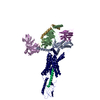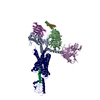[English] 日本語
 Yorodumi
Yorodumi- EMDB-24334: cryo-EM of human Gastric inhibitory polypeptide receptor GIPR bou... -
+ Open data
Open data
- Basic information
Basic information
| Entry |  | |||||||||
|---|---|---|---|---|---|---|---|---|---|---|
| Title | cryo-EM of human Gastric inhibitory polypeptide receptor GIPR bound to GIP | |||||||||
 Map data Map data | ||||||||||
 Sample Sample |
| |||||||||
 Keywords Keywords | Class B GPCR / glucagon-like peptide-1 receptor / G protein nucleotide exchange factor. / MEMBRANE PROTEIN | |||||||||
| Function / homology |  Function and homology information Function and homology informationgastric inhibitory polypeptide receptor binding / gastric inhibitory peptide receptor activity / glucagon family peptide binding / digestive system development / gastric inhibitory peptide signaling pathway / glucagon receptor binding / endocrine pancreas development / positive regulation of cAMP-mediated signaling / regulation of fatty acid biosynthetic process / desensitization of G protein-coupled receptor signaling pathway ...gastric inhibitory polypeptide receptor binding / gastric inhibitory peptide receptor activity / glucagon family peptide binding / digestive system development / gastric inhibitory peptide signaling pathway / glucagon receptor binding / endocrine pancreas development / positive regulation of cAMP-mediated signaling / regulation of fatty acid biosynthetic process / desensitization of G protein-coupled receptor signaling pathway / Synthesis, secretion, and inactivation of Glucose-dependent Insulinotropic Polypeptide (GIP) / response to selenium ion / response to fatty acid / negative regulation of adenylate cyclase activity / response to acidic pH / positive regulation of D-glucose transmembrane transport / G protein-coupled peptide receptor activity / triglyceride homeostasis / GTP metabolic process / exploration behavior / G protein-coupled dopamine receptor signaling pathway / response to lipid / response to starvation / PKA activation in glucagon signalling / peptide hormone binding / positive regulation of macroautophagy / hair follicle placode formation / developmental growth / D1 dopamine receptor binding / response to axon injury / intracellular transport / response to amino acid / Adenylate cyclase inhibitory pathway / renal water homeostasis / Hedgehog 'off' state / response to glucose / adenylate cyclase-activating adrenergic receptor signaling pathway / activation of adenylate cyclase activity / cellular response to glucagon stimulus / sensory perception of pain / adenylate cyclase activator activity / regulation of insulin secretion / adenylate cyclase-inhibiting G protein-coupled receptor signaling pathway / response to nutrient / adult locomotory behavior / trans-Golgi network membrane / generation of precursor metabolites and energy / female pregnancy / long-term synaptic potentiation / G protein-coupled receptor binding / negative regulation of inflammatory response to antigenic stimulus / bone development / G-protein beta/gamma-subunit complex binding / positive regulation of insulin secretion / Olfactory Signaling Pathway / adenylate cyclase-modulating G protein-coupled receptor signaling pathway / Activation of the phototransduction cascade / adenylate cyclase-activating G protein-coupled receptor signaling pathway / response to organic cyclic compound / hormone activity / G beta:gamma signalling through PLC beta / Presynaptic function of Kainate receptors / Thromboxane signalling through TP receptor / G protein-coupled acetylcholine receptor signaling pathway / G protein activity / G-protein activation / platelet aggregation / Activation of G protein gated Potassium channels / Inhibition of voltage gated Ca2+ channels via Gbeta/gamma subunits / memory / Prostacyclin signalling through prostacyclin receptor / response to peptide hormone / Glucagon signaling in metabolic regulation / G beta:gamma signalling through CDC42 / cognition / G beta:gamma signalling through BTK / ADP signalling through P2Y purinoceptor 12 / Sensory perception of sweet, bitter, and umami (glutamate) taste / Synthesis, secretion, and inactivation of Glucagon-like Peptide-1 (GLP-1) / photoreceptor disc membrane / Glucagon-type ligand receptors / response to calcium ion / Adrenaline,noradrenaline inhibits insulin secretion / Vasopressin regulates renal water homeostasis via Aquaporins / G alpha (z) signalling events / Glucagon-like Peptide-1 (GLP1) regulates insulin secretion / cellular response to catecholamine stimulus / ADORA2B mediated anti-inflammatory cytokines production / sensory perception of taste / ADP signalling through P2Y purinoceptor 1 / G beta:gamma signalling through PI3Kgamma / adenylate cyclase-activating dopamine receptor signaling pathway / Cooperation of PDCL (PhLP1) and TRiC/CCT in G-protein beta folding / GPER1 signaling / GDP binding / cellular response to prostaglandin E stimulus / Inactivation, recovery and regulation of the phototransduction cascade / G-protein beta-subunit binding / transmembrane signaling receptor activity / heterotrimeric G-protein complex Similarity search - Function | |||||||||
| Biological species |  Homo sapiens (human) / Homo sapiens (human) /   | |||||||||
| Method | single particle reconstruction / cryo EM / Resolution: 3.24 Å | |||||||||
 Authors Authors | Sun B / Kobilka BK | |||||||||
 Citation Citation |  Journal: Proc Natl Acad Sci U S A / Year: 2022 Journal: Proc Natl Acad Sci U S A / Year: 2022Title: Structural determinants of dual incretin receptor agonism by tirzepatide. Authors: Bingfa Sun / Francis S Willard / Dan Feng / Jorge Alsina-Fernandez / Qi Chen / Michal Vieth / Joseph D Ho / Aaron D Showalter / Cynthia Stutsman / Liyun Ding / Todd M Suter / James D Dunbar ...Authors: Bingfa Sun / Francis S Willard / Dan Feng / Jorge Alsina-Fernandez / Qi Chen / Michal Vieth / Joseph D Ho / Aaron D Showalter / Cynthia Stutsman / Liyun Ding / Todd M Suter / James D Dunbar / John W Carpenter / Faiz Ahmad Mohammed / Eitaro Aihara / Robert A Brown / Ana B Bueno / Paul J Emmerson / Julie S Moyers / Tong Sun Kobilka / Matthew P Coghlan / Brian K Kobilka / Kyle W Sloop /   Abstract: SignificanceTirzepatide is a dual agonist of the glucose-dependent insulinotropic polypeptide receptor (GIPR) and the glucagon-like peptide-1 receptor (GLP-1R), which are incretin receptors that ...SignificanceTirzepatide is a dual agonist of the glucose-dependent insulinotropic polypeptide receptor (GIPR) and the glucagon-like peptide-1 receptor (GLP-1R), which are incretin receptors that regulate carbohydrate metabolism. This investigational agent has proven superior to selective GLP-1R agonists in clinical trials in subjects with type 2 diabetes mellitus. Intriguingly, although tirzepatide closely resembles native GIP in how it activates the GIPR, it differs markedly from GLP-1 in its activation of the GLP-1R, resulting in less agonist-induced receptor desensitization. We report how cryogenic electron microscopy and molecular dynamics simulations inform the structural basis for the unique pharmacology of tirzepatide. These studies reveal the extent to which fatty acid modification, combined with amino acid sequence, determines the mode of action of a multireceptor agonist. | |||||||||
| History |
|
- Structure visualization
Structure visualization
| Supplemental images |
|---|
- Downloads & links
Downloads & links
-EMDB archive
| Map data |  emd_24334.map.gz emd_24334.map.gz | 226.1 MB |  EMDB map data format EMDB map data format | |
|---|---|---|---|---|
| Header (meta data) |  emd-24334-v30.xml emd-24334-v30.xml emd-24334.xml emd-24334.xml | 20.7 KB 20.7 KB | Display Display |  EMDB header EMDB header |
| Images |  emd_24334.png emd_24334.png | 106.1 KB | ||
| Filedesc metadata |  emd-24334.cif.gz emd-24334.cif.gz | 7.3 KB | ||
| Archive directory |  http://ftp.pdbj.org/pub/emdb/structures/EMD-24334 http://ftp.pdbj.org/pub/emdb/structures/EMD-24334 ftp://ftp.pdbj.org/pub/emdb/structures/EMD-24334 ftp://ftp.pdbj.org/pub/emdb/structures/EMD-24334 | HTTPS FTP |
-Validation report
| Summary document |  emd_24334_validation.pdf.gz emd_24334_validation.pdf.gz | 568.5 KB | Display |  EMDB validaton report EMDB validaton report |
|---|---|---|---|---|
| Full document |  emd_24334_full_validation.pdf.gz emd_24334_full_validation.pdf.gz | 568.1 KB | Display | |
| Data in XML |  emd_24334_validation.xml.gz emd_24334_validation.xml.gz | 6.8 KB | Display | |
| Data in CIF |  emd_24334_validation.cif.gz emd_24334_validation.cif.gz | 7.8 KB | Display | |
| Arichive directory |  https://ftp.pdbj.org/pub/emdb/validation_reports/EMD-24334 https://ftp.pdbj.org/pub/emdb/validation_reports/EMD-24334 ftp://ftp.pdbj.org/pub/emdb/validation_reports/EMD-24334 ftp://ftp.pdbj.org/pub/emdb/validation_reports/EMD-24334 | HTTPS FTP |
-Related structure data
| Related structure data |  7ra3MC  7rbtC  7rg9C  7rgpC M: atomic model generated by this map C: citing same article ( |
|---|---|
| Similar structure data | Similarity search - Function & homology  F&H Search F&H Search |
- Links
Links
| EMDB pages |  EMDB (EBI/PDBe) / EMDB (EBI/PDBe) /  EMDataResource EMDataResource |
|---|---|
| Related items in Molecule of the Month |
- Map
Map
| File |  Download / File: emd_24334.map.gz / Format: CCP4 / Size: 244.1 MB / Type: IMAGE STORED AS FLOATING POINT NUMBER (4 BYTES) Download / File: emd_24334.map.gz / Format: CCP4 / Size: 244.1 MB / Type: IMAGE STORED AS FLOATING POINT NUMBER (4 BYTES) | ||||||||||||||||||||||||||||||||||||
|---|---|---|---|---|---|---|---|---|---|---|---|---|---|---|---|---|---|---|---|---|---|---|---|---|---|---|---|---|---|---|---|---|---|---|---|---|---|
| Projections & slices | Image control
Images are generated by Spider. | ||||||||||||||||||||||||||||||||||||
| Voxel size | X=Y=Z: 0.648 Å | ||||||||||||||||||||||||||||||||||||
| Density |
| ||||||||||||||||||||||||||||||||||||
| Symmetry | Space group: 1 | ||||||||||||||||||||||||||||||||||||
| Details | EMDB XML:
|
-Supplemental data
- Sample components
Sample components
+Entire : cryo-EM of human Gastric inhibitory polypeptide receptor GIPR bou...
+Supramolecule #1: cryo-EM of human Gastric inhibitory polypeptide receptor GIPR bou...
+Supramolecule #2: Gastric inhibitory polypeptide GIP bound to GIP receptor GIPR
+Supramolecule #3: Trimeric stimulatory G protein
+Macromolecule #1: Guanine nucleotide-binding protein G(i) subunit alpha-3,Isoform G...
+Macromolecule #2: Guanine nucleotide-binding protein G(I)/G(S)/G(T) subunit beta-1
+Macromolecule #3: Single-chain variable fragment 16
+Macromolecule #4: Guanine nucleotide-binding protein G(I)/G(S)/G(O) subunit gamma-2
+Macromolecule #5: Nanobody 35
+Macromolecule #6: Gastric inhibitory polypeptide
+Macromolecule #7: Gastric inhibitory polypeptide receptor
-Experimental details
-Structure determination
| Method | cryo EM |
|---|---|
 Processing Processing | single particle reconstruction |
| Aggregation state | particle |
- Sample preparation
Sample preparation
| Concentration | 10 mg/mL |
|---|---|
| Buffer | pH: 7.5 |
| Vitrification | Cryogen name: ETHANE / Chamber humidity: 100 % / Chamber temperature: 293 K / Instrument: FEI VITROBOT MARK IV |
- Electron microscopy
Electron microscopy
| Microscope | FEI TITAN KRIOS |
|---|---|
| Specialist optics | Energy filter - Name: GIF Quantum LS / Energy filter - Slit width: 20 eV |
| Image recording | Film or detector model: GATAN K3 (6k x 4k) / Detector mode: COUNTING / Average exposure time: 1.5 sec. / Average electron dose: 53.6 e/Å2 |
| Electron beam | Acceleration voltage: 300 kV / Electron source:  FIELD EMISSION GUN FIELD EMISSION GUN |
| Electron optics | Illumination mode: FLOOD BEAM / Imaging mode: BRIGHT FIELD / Cs: 2.7 mm |
| Experimental equipment |  Model: Titan Krios / Image courtesy: FEI Company |
- Image processing
Image processing
| Startup model | Type of model: EMDB MAP EMDB ID: |
|---|---|
| Final reconstruction | Resolution.type: BY AUTHOR / Resolution: 3.24 Å / Resolution method: FSC 0.143 CUT-OFF / Software - Name: RELION (ver. 3.0) / Number images used: 145195 |
| Initial angle assignment | Type: NOT APPLICABLE |
| Final angle assignment | Type: NOT APPLICABLE |
 Movie
Movie Controller
Controller

























 Z (Sec.)
Z (Sec.) Y (Row.)
Y (Row.) X (Col.)
X (Col.)




















 Trichoplusia ni (cabbage looper)
Trichoplusia ni (cabbage looper)


